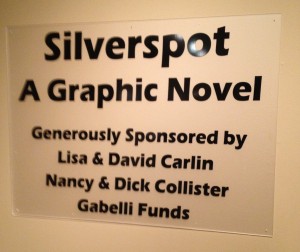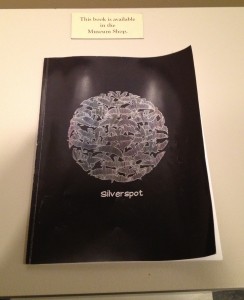Recently I found myself in Jackson Hole, Wyoming, home to the National Museum of Wildlife Art (I looked for the hole, and for the life of me couldn’t find it). My girlfriend, being something of a museum lover, suggested that we visit. I was more interested in the staying on the slopes, but sore muscles prevailed and thus we headed to see the exhibits.
 The temporary installation at the museum featured a graphic novel of sorts. The idea was that a number of local artists had each tuned a portion of an old manuscript into a page of a graphic novel, and the pages were displayed sequentially around the walls of the room. I was reminded of Scott McCloud’s explanation that the reason floors of a building are referred to as stories is because of the sequential imagery found in the stained glass windows of cathedrals. The manuscript, Silverspot, the Story of a Crow, was written in 1898 by Ernest Thompson Seton about a particular crow he often saw frequenting his property. And while it may sound as tedious as the less thrilling points of Thoreau’s Walden I, for the most part, found the entire exhibit utterly captivating.
The temporary installation at the museum featured a graphic novel of sorts. The idea was that a number of local artists had each tuned a portion of an old manuscript into a page of a graphic novel, and the pages were displayed sequentially around the walls of the room. I was reminded of Scott McCloud’s explanation that the reason floors of a building are referred to as stories is because of the sequential imagery found in the stained glass windows of cathedrals. The manuscript, Silverspot, the Story of a Crow, was written in 1898 by Ernest Thompson Seton about a particular crow he often saw frequenting his property. And while it may sound as tedious as the less thrilling points of Thoreau’s Walden I, for the most part, found the entire exhibit utterly captivating.
I didn’t realize at first that the images were all done by local artists, so I kept an eye out for a name I might know. About a third of the way through the exhibit it became clear to me that most of the contributing artists were inexperienced with creating sequential art. This isn’t to say that there weren’t beautiful pieces, but a majority of the pieces were simply a nice image with accompanying text pasted on. Some pieces, unfortunately, made the mistakes often seen in novice work; structuring things against the natural flow of an English reader’s eye, obfuscating text with overly complex imagery, things like that. Other pieces, however, were sublime. Beautiful art, an innate sense of flow and narrative, and that extra x-factor that makes comics special; where the sum of the parts yields something beyond a simple combination of words and pictures.
I sometimes wonder how a certain series would look had another artist been asked to work on it. Imagine being able to play out that thought experiment every time you turned the page (or stepped a few feet to the right). I adored probably a dozen or so of the pages on display, to the point where I couldn’t quite imagine how any one of the creators would have tackled the entire project on their own. Furthermore, I’m not even sure I could chose just one if I had to. A strange moment of sympathy for whoever has to make those decisions in the actual publishing world.
 The whole experience just felt so innovative and fresh. What a cool idea, right? And one with seemingly endless opportunity for continuation, expansion, and revision. I’ve recently been involved in helping with a museum renovation and I could easily see us commissioning something similar for some of our yet-to-be-filled exhibit space. I’ve been to other museums that had a stronger foundation in comics themselves, namely the Cartoon Art Museum in San Francisco. I really enjoyed my visit, it was when they had the Gerry Conway exhibit up, and I ogled over the detail and confidence in his pencils. But, seeing as how the majority of the display were disparate pages from throughout his career, the entire exhibit was ironically lacking in the strong narrative I knew a master creator like Conway was capable of. I still enjoyed myself, but the experience felt like walking through an art gallery, not like walking through a tangible comic book.
The whole experience just felt so innovative and fresh. What a cool idea, right? And one with seemingly endless opportunity for continuation, expansion, and revision. I’ve recently been involved in helping with a museum renovation and I could easily see us commissioning something similar for some of our yet-to-be-filled exhibit space. I’ve been to other museums that had a stronger foundation in comics themselves, namely the Cartoon Art Museum in San Francisco. I really enjoyed my visit, it was when they had the Gerry Conway exhibit up, and I ogled over the detail and confidence in his pencils. But, seeing as how the majority of the display were disparate pages from throughout his career, the entire exhibit was ironically lacking in the strong narrative I knew a master creator like Conway was capable of. I still enjoyed myself, but the experience felt like walking through an art gallery, not like walking through a tangible comic book.
It also worked from an exhibit-design point of view. If you’re anything like me, you head into a museum with the intent to get as much from the experience as possible. You read the labels carefully, spend time examining whatever object is on display. But then you start to skim the labels, glance at the object. Soon you’re just looking for a bench because why do you have to stand for 2-3 hours to look at paintings? Can’t they install a moving walkway in this freaking place? Why is it so quiet? How can anyone be expected to listen to the entire audio tour? Oh, there’s another exhibit still to go through? Can we just jog through it on our way out the door because I haven’t eaten or sat down in 4 hours? Upon writing this, I realize it is not dissimilar from a comic convention, but with fewer cosplayers.

My point being that this exhibit hit the high notes. It was brief, but not so brief that I felt it wasn’t worth the price of admission. I was engaged the entire way through. There were stools to grab, which I’ll admit to using referring once more to how sore my legs were from skiing. And at the end of the exhibit I felt like I’d truly had an experience. I’d seen something in a form that couldn’t have been done in any other way. I’d walked through a comic, been told a compelling narrative in an innovative way, and enjoyed the novelty, the artistry, and the story itself immensely.
Needless to say, I left the exhibit transfixed and eager to purchase the collected book from the gift shop. In the exhibit they were clever to point out that the volume was indeed available for purchase. For all that we lament how movies don’t drive comics sales, this place had figured it out. Naturally, the book was sold out, and there is a substantial waiting list for the next printing, which I of course added my name to. But in the end, it was just a really cool way to experience a comic that I’d never expected and by which I was absolutely delighted.
How about you? You ever had the “comics in a museum” experience? Did it work as well as it did for me? What book would you like to walk through? Exhibit your opinions in the comments.
Ryan Haupt is still sore from skiing if he’s being perfectly honest. He also exhibits himself audibly each week on the podcast Science… sort of.


I did see this similar structure to the storyboard for the film BRAZIL. Never been to a comics exhibit, but its a cool idea worth expanding and experimenting on, you’re right. I’d like to see something like this for The UNWRITTEN. I’m very into this book right now.
On a side note: EVERY TOWN should end with HOLE. Boise Hole, Springfield Hole, just the towns not the cities.
This sounds awesome. Very creative.
I’d love to see Cormac McCarthy’s Blood Meridian brought to life this way. The imagery in that book is so vivid and such a crucial part of the narrative, and it’d be really interesting to see different illustrators interpret it.
That’s really cool. I dig it. Wish I lived closer to take it in.
Reminds me of something I did a few years ago. I had a gallery show and took each piece as a representation of an activity during one night of my main character’s life. It was called the Heavy Show.
Check it out if you’re interested. It was epic.
http://brattyben.deviantart.com/gallery/28017788
good recommendation. another great, permanent version of this is the comics museum in brussels. it’s a bit not-in-america-y, but if any of ya’ll are in europe, it’s definitely worth checking out. my wife and i went there a few years ago while on our honeymoon (moral of the story: my wife kicks ass), and as a result i’ve been meaning to buy some poisson pilote books forever. presuming they’re translated into english.
here’s the link: http://www.comicscenter.net/en/home